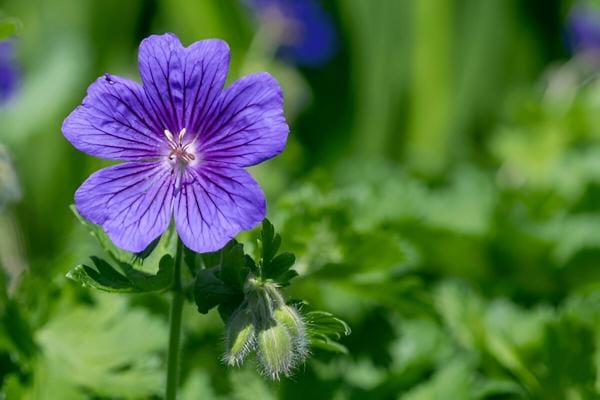
Meet Your Garden’s New Best Friend: The Cranesbill Geranium
Imagine a plant that offers beautiful flowers for months on end, asks for very little in return, and comes back more vibrant each year. It sounds like a gardener’s dream, but it’s a reality with the cranesbill geranium.
If you’ve ever felt overwhelmed by complicated plant care or disappointed by flowers that don’t last, this guide is for you. We’re going to walk through everything you need to know about these garden superstars, in simple terms, to help you grow them with confidence.
“…If you’ve ever felt overwhelmed by complicated plant care or disappointed by flowers that don’t last, this guide is for you. To see just how beautiful and versatile these plants are in a real garden setting, take a look at this wonderful video tour:”
“As you can see, their charm lies in their simple beauty and their ability to effortlessly fill a space with color.”
But first, let’s clear up a common mix-up that trips up even experienced gardeners.
What’s the Difference Between a Geranium and a Cranesbill?
Walk into any garden center in the summer, and you’ll see pots of bright red, pink, and white “geraniums.” These are the classic plants for window boxes and containers. However, botanically speaking, these are Pelargoniums. They are wonderful, but they are tender annuals, meaning they only last for one season in most climates.
The cranesbill geranium, on the other hand, is the “true geranium.” It’s a tough, reliable perennial.
- Cranesbill (True Geranium): A hardy perennial that dies back in winter and regrows from its roots in the spring. It’s a long-term resident of your garden.
- Pelargonium (Common Geranium): A tender annual that needs to be replanted each year or brought indoors over winter.
Its charming name, “cranesbill,” comes from the shape of its long, pointed seed pod, which looks just like the beak of a crane. So, when you’re looking for a plant that will be a permanent, fuss-free part of your landscape, the cranesbill geranium is what you want.
The Complete Growing Guide: Your Path to Success
One of the best things about hardy cranesbill geraniums is their forgiving nature. They don’t demand perfection. Here’s how to give them a happy home.
Do Cranesbill Geraniums Like Sun or Shade?
This is the most asked question, and the answer is one you’ll love: they are incredibly versatile!
- Full Sun (6+ hours of direct light): Most varieties will produce the most abundant blooms in a sunny spot. This is especially true for the vibrant bloody cranesbill geranium (Geranium sanguineum).
- Partial Shade (4-6 hours of sun): This is the sweet spot for many varieties, including the famous cranesbill geranium ‘Rozanne’. The foliage will stay lush, and the flowering will still be spectacular. Afternoon shade is particularly welcome in very hot climates.
- Shade (Less than 4 hours of sun): While you won’t get as many flowers, certain varieties are adapted for shadier corners, where they provide beautiful textured foliage. Look for Geranium phaeum (Mourning Widow) or Geranium macrorrhizum for these spots.
Where Is the Best Place to Plant Cranesbill Geranium?
Think about what you want your plant to do. Do you need to fill a gap, cover the ground, or create a soft border?
The best location has soil that is reasonably fertile and, most importantly, well drained. These plants hate sitting in soggy soil, which can lead to root rot. If you have heavy clay soil, amend it with compost or other organic matter to improve its structure.
Planting and Spacing
Plant new cranesbills in the spring or early fall. This gives them time to establish their root systems before the stress of summer heat or winter cold. Dig a hole twice as wide as the nursery pot and just as deep. Gently place the plant in, backfill with soil, and water it well.
Pay attention to spacing give them room to grow! Mounding types like ‘Rozanne’ can easily spread 2 feet (60 cm) wide, so space them about 18-24 inches apart.
Watering and Fertilizing
- Watering: Water newly planted geraniums regularly during their first year. Once established, they are quite drought-tolerant. You’ll only need to water them during extended dry spells.
- Fertilizing: Cranesbills are not heavy feeders. A simple top-dressing of compost around the base of the plant each spring is usually all they need to thrive.
Pruning for More Flowers
This is the secret to keeping your plants looking tidy and encouraging more blooms. After the first main flush of flowers begins to fade in mid summer, many varieties can look a bit tired. Don’t be afraid to give them a haircut! Shear the entire plant back by about one-third. This will stimulate a fresh flush of healthy new foliage and, in many cases, a second round of flowers.
Meet the Stars: Popular Cranesbill Varieties
With hundreds of varieties available, here are a few standouts you can’t go wrong with:
- Cranesbill Geranium ‘Rozanne’: The undisputed queen of perennials. ‘Rozanne’ produces stunning violet-blue flowers with white centers continuously from late spring until the first frost. She is vigorous, reliable, and spectacular in borders, as a ground cover, or spilling from containers.
- Bloody Cranesbill Geranium (Geranium sanguineum): Don’t let the dramatic name put you off! It refers to the brilliant crimson-red color the foliage turns in the fall. The flowers are a stunningly intense magenta. It forms a neat, low-growing mound, making it perfect for the front of a border or a rock garden. If you love the idea of red geraniums but want a hardy perennial, the fall color of this variety is a fantastic choice.
- Geranium ‘Karmina’ Cranesbill: A phenomenal ground cover. This variety forms a dense mat of fragrant, weed-suppressing foliage. In late spring, it’s covered in a profusion of lovely lilac-pink flowers. It’s a true problem-solver for bare spots.
Companion Planting: Creating Beautiful Garden Partnerships
Cranesbill geraniums are team players. Their soft, mounding habit is perfect for hiding the “bare legs” of taller plants and weaving a garden bed together. Try planting them with:
- Roses: They are a classic partner for roses, hiding the thorny lower stems and providing a continuous splash of color.
- Hostas and Ferns: In shadier spots, their delicate flowers contrast beautifully with the bold leaves of hostas and the fine texture of ferns.
- Ornamental Grasses: The soft mounds of geraniums look wonderful at the base of upright grasses like Calamagrostis ‘Karl Foerster’.
Troubleshooting: A Nearly Problem-Free Plant
One of the reasons we love hardy cranesbill geraniums is that they are rarely bothered by pests or diseases. However, no plant is perfect. Here’s what to look out for this is the information other guides often miss.
- Powdery Mildew: In humid weather or crowded conditions, you might see a white, dusty coating on the leaves.
- Solution: Improve air circulation by thinning out surrounding plants. Water at the base of the plant, not on the leaves. You can trim off heavily affected foliage.
- Slugs and Snails: Young, tender growth in the spring can sometimes be nibbled by slugs.
- Solution: These plants are so vigorous they usually outgrow the damage quickly. If it becomes a problem, use your preferred method of slug control.
- Rust: You might occasionally see small orange or brown spots on the undersides of leaves.
- Solution: This is rarely serious. Remove the affected leaves to prevent it from spreading and ensure good air circulation.
Propagation: More Plants for Free!
Has your cranesbill gotten too large, or do you simply want to spread the joy to another part of your garden? Division is easy!
The best time is in the spring or early fall. Simply dig up the entire clump with a spade. Use the spade or a garden knife to slice the clump into several smaller sections, making sure each section has a healthy set of roots and some top growth. Replant these new divisions immediately at the desired depth and water them in well.
“…The best time is in the spring or early fall. Simply dig up the entire clump with a spade. The process is much easier to understand when you see it in action. This excellent video demonstrates the technique step-by-step, showing you exactly how to get more plants for free:”
“Once you’ve watched the demonstration, you’ll see just how simple it is to expand your collection or share these wonderful plants with friends and family.”
Frequently Asked Questions (FAQ)
1. Do cranesbill geraniums like sun or shade?
They are wonderfully adaptable! Most flower best in full sun to partial shade, but many varieties tolerate shady conditions, where they are grown for their attractive foliage.
2. What is the difference between geranium and cranesbill?
“Cranesbill” is the common name for the hardy, perennial Geranium that returns every year. The common “geranium” found in summer pots is a Pelargonium, which is a tender annual in most climates.
3. Where is the best place to plant cranesbill geranium?
The ideal spot has well-drained soil and receives full sun or partial shade. They are perfect for filling gaps in borders, covering the ground to suppress weeds, or adding color to rock gardens and containers.
4. How tall does a cranesbill geranium get?
Height varies widely by type. Low-growing ground covers like Geranium sanguineum stay around 8-12 inches (20-30 cm) tall, while mounding varieties like ‘Rozanne’ can reach 18-24 inches (45-60 cm) in height and spread even wider.
A Final Thought
The cranesbill geranium truly is a gift to gardeners. It’s a plant that works hard so you don’t have to, rewarding you with months of beauty for just a little bit of care. Whether you’re a beginner looking for a foolproof flower or an expert designing a complex border, there is a cranesbill geranium that is perfect for you.




